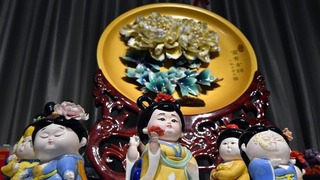China's Ancient Capital——Introduction to Luoyang
Luoyang lives vibrantly in China's present and yet few cities on earth can evoke so strongly its past. For over 2.500 years, emperors, soldiers, artists, monks and common citizens left their mark here. The result is a city full of stunning relics of an ancient history while to the north thunders Huanghe, China's mother river.
Named for its position on the north or sunny(“yang”)side of the Luo River, Louyang is the capital of thirteen Chinese dynasties. As one of the world's greatest cities, Luoyang was centre-stage in major moments of China's history, from the western expansion of the Han to the glorious cultural flowering of the Tang. Giants have walked its streets, from philosophers Confucius and laozi to Tang poets and the 96 emperors who ruled from Luoyang.
Luoyang was also a landing point for Buddhism in China, a legacy commemorated by historic White Horse Temple and by the great Buddhist grottoes at Longmen, started during the Northern Wei period. The Longmen Grottoes are a peerless treasure trove of ancient religious art which draws visitors in the thousands. Yet beyond this poetry in stone, Luoyang's legacy as an ancient capital has been largely overlooked by visitors.
In recent years, though, stunning discoveries have been made that illuminate the very beginnings of Chinese culture. Ancient treasures adorn the city's more than sixty museums which curate every aspect of the city's imperial past from ancient tombs to Tang pottery. Here you May discover relics from the time of China's mysterious first dynasty, the Xia, or stunning cultural artifacts showing the influence of the Silk Road, of which Luoyang was the eastern starting point.
Much of the city's ancient heritage, long buried underfoot, is gradually coming to light. Some sites have been imaginatively reconstructed, like the Lijing Gate in the Old City, which provides a coordinate to map magnificent Tang Luoyang onto the present day. The old palace of the Tang city has been lavishly reimagined right above its original foundations, which are visible through a glass floor. Other sites such as an ancient temple that schooled emperors are concealed within the city's courtyards. Walk around the centre of Luoyang and for all the shabby modernity you will know you are following in the footsteps of greats of the Chinese past.
The ancient city's intangible heritage is also felt everywhere from the street versions of imperial cuisine which are served in the night market to the drum village founded by Silk Road migrants more than one thousand years ago, and the peonies that flood the city at the spring peony festival, which has been held in the city since the time of China's only empress, Wu Zetian. Sit in a back alley noodle joint on Yunhe Street, once a central axis of Tang Luoyang, enjoying a bowl of Luoyang tofu soup in the early morning, with the sounds and smells of the awakening old city all around, and you can almost reach out and touch the past.
Beyond the urban area are spectacular natural sites, such as Dameishan and Longtan Gorge, which will be appreciated by both history and nature lovers Meanwhile to the north at Xiaolangdi is one of the most dramatic places to encounter the Yellow River, known down the ages as the mother of Chinese civilization.
(via Luoyang Culture, Radio, Television and Tourism Bureau)

